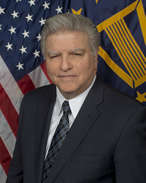
DISA ramps up MilCloud 2.0 as it plans to shut down version 1 in 2019
John Hale, DISA’s chief of enterprise applications, said his office is helping the military services and agencies do the hard work before moving to the cloud.
While industry frets over the Defense Department’s mega cloud initiative known as JEDI, the Defense Information Systems Agency (DISA) is coolly setting the military services and agencies down a similar path.
DISA’s MilCloud program is seeing more interest than it expected and with version 2.0 reaching its provisional authority to operate (ATO) for the highest levels of unclassified data in March, the appeal of the offering is only increasing.
“We are looking at probably 2-3-4 times the increase of volume than we originally anticipated right off the bat, which is a good news thing. It shows there is a lot of demand for cloud capabilities inside the department,” said John Hale, DISA’s chief of enterprise applications, at the FCW Cloud Summit on April 18. “I think a lot of mission partners see MilCloud 2 as a gateway capability. As they shift away from traditional hosting in their data centers into a cloud model, MilCloud 2 provides them a little bit of a comfort factor because the data stays on premise.”
Hale said once mission areas are comfortable with the cloud, they can consider whether going solely commercial makes sense or if moving more to the MilCloud environment is better.
DISA launched MilCloud 1.0 in 2013 and awarded CSRA, which General Dynamics IT recently bought, a $500 million, eight-year contract to run MilCloud 2.0 in June 2017.
Hale said DISA continues to bring new customers onto MilCloud 1.0 and have just started to bring on new partners to MilCloud 2.0 now that it received its provisional ATO.
“We are working with all of the mission partners who are leveraging MilCloud 1.0 on a migration plan,” he said. “We have laid out a plan that over the next four-to-five months migrating most all of the MilCloud 1.0 capabilities onto MilCloud 2.0. Then, the plan is to probably shutdown MilCloud 1.0 sometime in late fiscal year 2019.”
The military services and agencies have struggled up to this point to adopt cloud technologies, but Hale said there is a recent trend of DoD moving away from traditional hosting as well as more than the use of virtual machines.
Hale said DISA spends a lot of time educating potential users of MilCloud about what capabilities exist and the security of them.
“We make sure they enter into the cloud world with their eyes wide open with all the options laid out before them,” he said. “We are all about making sure they have all available capabilities in front of them so they can make the right business decision about which way a particular application is supposed to go. Unfortunately in the world of cloud, there is no one silver bullet or one-size fits all. Application A may fit well in one environment and application B may fit well in a different commercial cloud capability.”
Hale said each individual service or combatant command is free to choose its own path to the cloud. DISA’s end goal is simple: Making sure the warfighter has the capabilities to meet their demands and needs.
“We don’t anticipate a MilCloud 3.0. The MilCloud 2.0 contract we let was a three-year contract with five one-year options and the contract was designed to encourage commercial parity. As commercial cloud evolves, we expect our MilCloud 2.0 capability to evolve in-kind,” he said. “What we are spending a lot of time on and where we are making investments now is how to strengthen our ties with off-premise commercial cloud providers, how we strengthen our security relationships with them and how we make sure that all of that works in a much better way. In the past you’ve heard the department talk about cloud access points (CAPs) and I think what we will do is shift away from CAPs into more of a cloud security broker where we can leverage commercial security tools to meet those needs. I think you will see a more diverse ability to connect to the off-premise commercial cloud. That is where we are spending a lot of effort.”
Copyright © 2024 Federal News Network. All rights reserved. This website is not intended for users located within the European Economic Area.
Jason Miller is executive editor of Federal News Network and directs news coverage on the people, policy and programs of the federal government.
Follow @jmillerWFED
Related Stories





